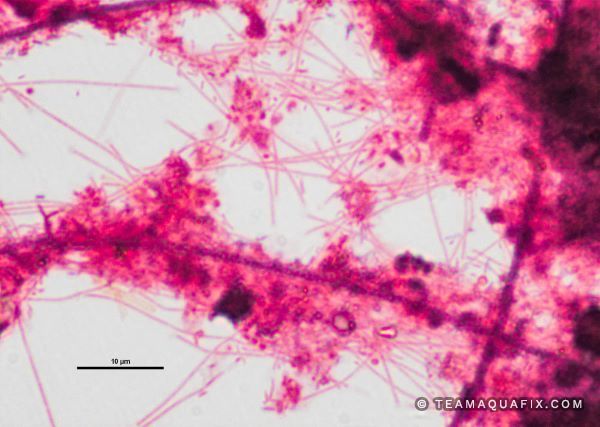
Haliscomenobacter hydrossis is an indicator organism of low D.O. but if abundant enough can cause bulking and difficulties forming floc
If Haliscomenobacter hydrossis is indicating or causing issues within a wastewater plant, we recommend increasing aeration to raise the oxidation/reduction potential in your wastewater plant. If increasing aeration is not possible, Aquafix recommends the addition of OxyFresh to help combat low dissolved oxygen levels. If you are having difficulties maintaining adequate D.O. levels, we recommend consulting with us to address potential issues with aeration or overloading.
Because wastewater issues and the cause behind filaments can be complex, we recommend our Filament ID and Microanalysis. This not only confirms organism ID, but looks at biological indicators, plant design, and incoming substrates to decode your unique process.
Haliscomenobacter hydrossis is a rigid, short (<100 µm), and thin (0.5 µm) filamentous bacterium with a sheath, and cells that are not usually visible. H. hydrossis can be identified under 1000x magnification. This filament stains both Neisser and Gram negative. If this filament is observed, it is a strong indication of low dissolved oxygen conditions. This filament is frequently observed in low levels growing from floc and does not cause issues. However, when present in a high abundance, Haliscomenobacter hydrossis can cause bulking to occur.
A wastewater mixed liquor sample was being sent to Aquafix from Brazil for analysis. The sample was held up in customs for two weeks. By the time the sample was received an abundance of H. hydrossis was present. This abundance was believed to have grown during transit. This is unusual as it is commonly thought that aerobic filamentous bacteria are unable to survive in anaerobic conditions as were present in the sample bottle. Our laboratory continues research into the possibility of Haliscomenobacter hydrossis surviving in anaerobic conditions.
Eikelboom, D.H. & van Buijsen, H.J.J. (1983). Microscopic sludge investigation manual.
Jenkins, D., Richard, M.G., & Daigger, G.T. (2004). Manual on the causes and control of activated sludge bulking,
foaming, and other solids separation problems (3rd ed). CRC Press LLC.

39041 RGE RD 283,
Red Deer County, AB T4E 0M2
Phone: 1-888-466-0031 |
Fax: 1-888-507-9716
To place an order, please fill out the required fields below and proceed to checkout. Ensure all information is accurate, and feel free to contact our support team if you have any questions or need assistance. Thank you for choosing us!